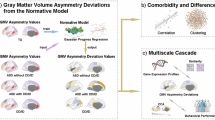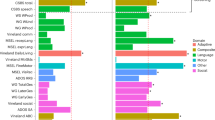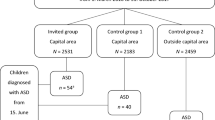Abstract
Background
We investigated the effectiveness of individual-Early Start Denver Model (I-ESDM) and group-ESDM (G-ESDM) intervention in children with autism spectrum disorder (ASD) at varying ability levels.
Methods
A total of 404 children were divided into I-ESDM (n = 237) and G-ESDM (n = 167) groups, receiving 3-month of intervention. The I-ESDM group had a staff-to-child ratio of 1:1, while the G-ESDM group had a ratio of 2:6. Clinical symptoms, neurodevelopment, and parenting stress were evaluated both pre- and post-treatment.
Results
After 3 months, both interventions significantly improved clinical symptoms, neurodevelopment, and reduced parenting stress in children with ASD. In the language age group under 2 years, the I-ESDM subgroup showed greater improvements in clinical symptoms compared to the G-ESDM subgroup. In the ≥2-year language age group and the general quotient (GQ) ≥ 70 group, the G-ESDM subgroup demonstrated greater improvements in clinical symptoms and neurodevelopment compared to the I-ESDM subgroup.
Conclusion
Both I-ESDM and G-ESDM effectively improve clinical symptoms, neurodevelopment, and reduce parenting stress in children with ASD. I-ESDM was more effective for children with a language age <2 years, while G-ESDM showed better outcomes for those with a language age ≥2 years or GQ ≥ 70.
Impact
-
After 3 months, both individual-Early Start Denver Model (I-ESDM) and group-ESDM (G-ESDM) significantly improved clinical symptoms, neurodevelopment, and reduced parenting stress in children with ASD.
-
The I-ESDM subgroup showed greater improvements in clinical symptoms in children under 2 years of age.
-
The G-ESDM subgroup demonstrated superior improvements in clinical symptoms and neurodevelopment in children aged ≥2 years or those with GQ ≥ 70.
This is a preview of subscription content, access via your institution
Access options
Subscribe to this journal
Receive 14 print issues and online access
$259.00 per year
only $18.50 per issue
Buy this article
- Purchase on SpringerLink
- Instant access to full article PDF
Prices may be subject to local taxes which are calculated during checkout

Similar content being viewed by others
Data availability
The data utilized in this study were obtained from clinical sources. Due to concerns regarding personal privacy, raw data cannot be publicly shared. However, requests for access to the data can be made to the corresponding author of the article. The data supporting this study’s findings are available from the corresponding author upon reasonable request.
References
Battle, D. E. Diagnostic and statistical manual of mental disorders (DSM). Codas 25(2), 191–2 (2013).
Maenner, M. J. et al. Prevalence and characteristics of autism spectrum disorder among children aged 8 years—autism and developmental disabilities monitoring network, 11 Sites, United States, 2020. MMWR Surveill. Summ. 72(2), 1–14 (2023).
Dawson, G. et al. Randomized, controlled trial of an intervention for toddlers with autism: the Early Start Denver Model. Pediatrics 125(1), e17–23 (2010).
Estes, A. et al. Long-term outcomes of early intervention in 6-year-old children with autism spectrum disorder. J. Am. Acad. Child Adolesc. Psychiatry 54(7), 580–7 (2015).
Fuller, E. A. et al. The effects of the early start Denver Model for children with autism spectrum disorder: a meta-analysis. Brain Sci. 10, 368 (2020).
Reichow, B. et al. Early intensive behavioral intervention (EIBI) for young children with autism spectrum disorders (ASD). Cochrane Database Syst. Rev. 5, Cd009260 (2018). p.
Vivanti, G. et al. Characteristics of children on the autism spectrum who benefit the most from receiving intervention in inclusive versus specialised early childhood education settings. Autism Res. 15(11), 2200–2209 (2022).
Williams White, S., Keonig, K. & Scahill, L. Social skills development in children with autism spectrum disorders: a review of the intervention research. J. Autism Dev. Disord. 37(10), 1858–68 (2007).
Hastings, R. P. & Beck, A. Practitioner review: stress intervention for parents of children with intellectual disabilities. J. Child Psychol. Psychiatry 45(8), 1338–49 (2004).
Cotugno, A. J. Social competence and social skills training and intervention for children with Autism Spectrum Disorders. J. Autism Dev. Disord. 39(9), 1268–77 (2009).
Wang, L. et al. Effect of the early start Denver model on children with autism spectrum disorder syndrome of different traditional chinese medicine types in Northeast China. Front Pediatr. 10, 851109 (2022).
Vivanti, G. et al. Effectiveness and feasibility of the early start Denver model implemented in a group-based community childcare setting. J. Autism Dev. Disord. 44(12), 3140–53 (2014).
Bent, C. et al. Predictors of developmental and adaptive behaviour outcomes in response to early intensive behavioural intervention and the early start denver model. J. Autism Dev. Disord. 54(7), 2668–2681 (2024).
İncekaş Gassaloğlu, S. et al. Validity and reliability analysis of Turkish Version of Childhood Autism Rating Scale. Turk. Psikiyatr. Derg. 27(4), 266–274 (2016).
Al Backer, N. B. Correlation between Autism Treatment Evaluation Checklist (ATEC) and Childhood Autism Rating Scale (CARS) in the evaluation of autism spectrum disorder. Sudan J. Paediatr. 16(1), 17–22 (2016).
Barroso, N. E. et al. Psychometric properties of the Parenting Stress Index-Short Form (PSI-SF) in a high-risk sample of mothers and their infants. Psychol. Assess. 28(10), 1331–1335 (2016).
Li, P. Y. et al. The Griffiths Development Scales-Chinese (GDS-C): a reliable and valid neurodevelopmental assessment tool in children with ASD aged 3-8 years old in Tianjin, China. Asian J. Psychiatr. 52, 102144 (2020).
Cirelli, I., Bickle Graz, M. & Tolsa, J. F. Comparison of Griffiths-II and Bayley-II tests for the developmental assessment of high-risk infants. Infant Behav. Dev. 41, 17–25 (2015).
Vivanti, G. et al. Outcomes of children receiving Group-Early Start Denver Model in an inclusive versus autism-specific setting: a pilot randomized controlled trial. Autism 23(5), 1165–1175 (2019).
Vivanti, G. et al. Brief report: Predictors of outcomes in the Early Start Denver Model delivered in a group setting. J. Autism Dev. Disord. 43(7), 1717–24 (2013).
Vivanti, G., Trembath, D. & Dissanayake, C. Atypical monitoring and responsiveness to goal-directed gaze in autism spectrum disorder. Exp. Brain Res. 232(2), 695–701 (2014).
Zhou, B. et al. Effects of parent-implemented early start Denver model intervention on Chinese toddlers with autism spectrum disorder: a non-randomized controlled trial. Autism Res. 11(4), 654–666 (2018).
van Noorden, L. E., Sigafoos, J. and Waddington, H. L. Evaluating a two-tiered parent coaching intervention for young autistic children using the Early Start Denver Model. Adv. Neurodev. Disord. 1–21 (2022).
Gómez, E. & Strasser, K. Language and socioemotional development in early childhood: the role of conversational turns. Dev. Sci. 24(5), e13109 (2021).
Conti-Ramsden, G. et al. Health, employment and relationships: correlates of personal wellbeing in young adults with and without a history of childhood language impairment. Soc. Sci. Med. 160, 20–8 (2016).
Misirliyan, S. S., Huynh, A. P. Development milestones, in StatPearls. 2022, StatPearls Publishing Copyright ©2022, (StatPearls Publishing LLC, 2022).
Tachibana, Y. et al. Meta-analyses of individual versus group interventions for pre-school children with autism spectrum disorder (ASD). PLoS One 13(5), e0196272 (2018).
Maenner, M. J. et al. Prevalence and characteristics of autism spectrum disorder among children aged 8 years—autism and developmental disabilities monitoring network, 11 sites, United States, 2018. MMWR Surveill. Summ. 70(11), 1–16 (2021).
Acknowledgements
The authors are deeply thankful to all the families who contributed their time to this study in order to better understand autism spectrum disorder. This study was supported by the Health Science and Technology Capacity Improvement Project of Jilin Province (Grant Number: 2022LC104).
Author information
Authors and Affiliations
Contributions
J.-Y.F. conceptualized and designed the study and drafted the initial manuscript. M.-S.B., H.-Y.D., Y.X., Y.-M.L., H.M., Z.A.M. and L.S. collected data, data analysis and interpretation. F.-Y.J. conceptualized and designed the study, and coordinated and supervised the whole research process. All authors approved the final manuscript as submitted and agree to be accountable for all aspects of the work.
Corresponding author
Ethics declarations
Competing interests
The authors declare no competing interests.
Ethics statement
The study protocol was approved by the Ethics Committee of the First Hospital of Jilin University (approval no. 2017-307) and registered with the Chinese Clinical Trial Register Center on November 02, 2017 (registration no.: ChiCTR-IOR-17013217). Informed consent was obtained from the parents of the study participants before enrollment.
Consent statement
The study was conducted according to the guidelines of the Declaration of Helsinki, and approved by the Ethics Committee of First Hospital of Jilin University. Informed consent was obtained from all subjects involved in the study.
Additional information
Publisher’s note Springer Nature remains neutral with regard to jurisdictional claims in published maps and institutional affiliations.
Supplementary information
Rights and permissions
Springer Nature or its licensor (e.g. a society or other partner) holds exclusive rights to this article under a publishing agreement with the author(s) or other rightsholder(s); author self-archiving of the accepted manuscript version of this article is solely governed by the terms of such publishing agreement and applicable law.
About this article
Cite this article
Feng, Jy., Bai, Ms., Dong, Hy. et al. Effectiveness of individual versus group Early Start Denver Model interventions in children with autism spectrum disorder. Pediatr Res (2025). https://doi.org/10.1038/s41390-025-04375-5
Received:
Revised:
Accepted:
Published:
DOI: https://doi.org/10.1038/s41390-025-04375-5



